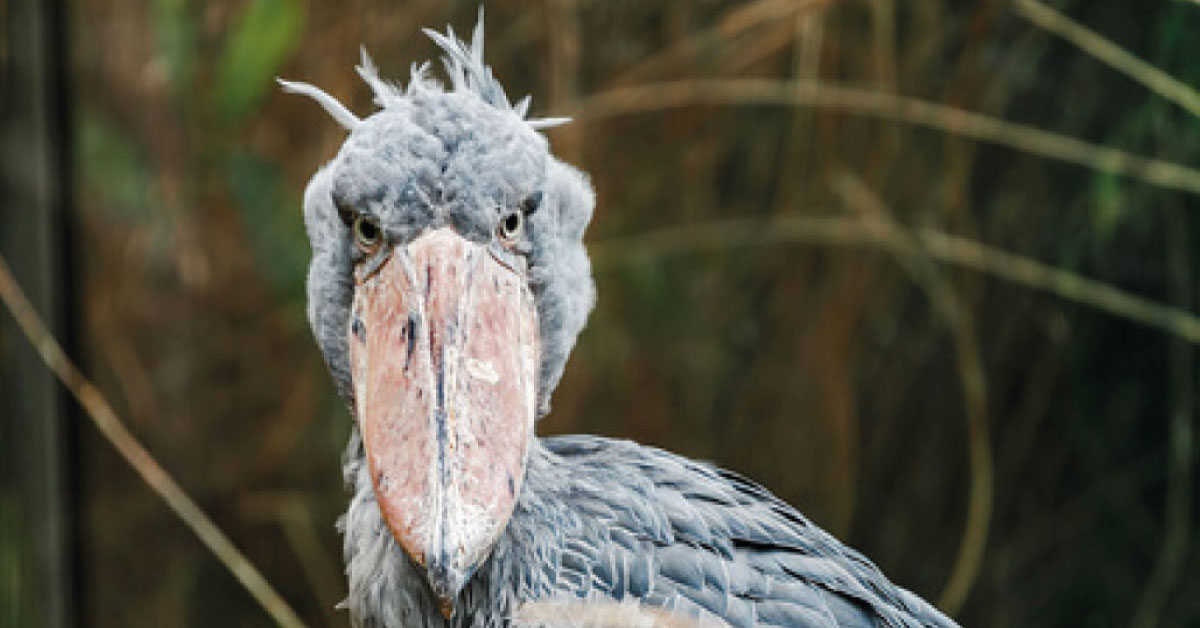The Shoebill is one of them.

Its scientific name is “Balaeniceps rex,” as well as the Tyrannosaurus, although in reality, these two do not have much to do. When it comes to scientific names, there are words repeated in species that are not alike.
“Rex” comes from Latin and means “king,”; while “balances” means “whale head,”; so this bird is a whale-headed king or something like that. That is why we will better call it by its common name: picozapato; which was given to him by that characteristic beak.
Quase todo dia me marcam em alguma publicação que tem vídeo ou foto desse colega aqui, perguntando “o que é”, “da onde vem” e principalmente “parece um dinossauro”. Resolvi então parar pra explicar, aí das próximas vezes o ctrlC + ctrlV vai facilitar minha vida. Segue o fio. pic.twitter.com/NEkwChWSjO
— Pirula (@Pirulla25) June 2, 2021
Pirula is a Brazilian biologist and scientific disseminator who made a Twitter thread explaining what is related to this animal. As he mentions, all the time, they are asking what it is. Here we tell you the most relevant information.
The shoebill inhabits the swamps of eastern Africa, between South Sudan and Zambia. Although it has relatively long and slender legs, it spends its time in shallow water; its limbs are powerful and allow it to spend a lot of time immobile and walking through muddy waters.
They weigh up to 7 kilograms and can reach almost a meter and a meter in height; that is to say, it is a rather large birds.
De fato, ele é chamado eventualmente de cabeça-de-baleia, mas o mais comum é “cegonha bico-de-sapato”. Por causa do seu aspecto e alguns detalhes anatômicos por muito tempo foi considerado uma cegonha, como os nossos jaburus. pic.twitter.com/WvWBz4cSXV
— Pirula (@Pirulla25) June 2, 2021
They spend most of their time resting to save energy for hunting. Like any predator, the shoebill remains perfectly still until it sees its prey and launches its attack. The curved tip of its beak serves to hold its prey better; It feeds on fish and frogs.
But don’t be fooled by its menacing beak; Actually, these birds are very docile, they are not afraid of humans, and they are even good at interacting with them and they even greeting them. They are also straightforward to keep in captivity, but the hard part is getting them to reproduce.
As áreas pantanosas onde vivem estão cada vez mais sendo usadas para agropecuária, seja drenando os pântanos pra irrigação, despejando agrotóxicos de maneira inadequada, ou pelo gado que pisoteia os ninhos e mata os filhotes e ovos. pic.twitter.com/KVxwMNjNJB
— Pirula (@Pirulla25) June 2, 2021
Despite having survived several catastrophes, this species is in danger of extinction. According to the International Union for Conservation of Nature (IUCN) its status is “vulerable”.
It is estimated that there are only 5,000 living specimens left, but some believe that the number is optimistic and does not exceed 3,300 birds.
There are several reasons why the shoebill is in this situation; the most significant from which others derive is the human being.
The swampy regions where it lives are being destroyed for agriculture. They drain the swamps for irrigation, use pesticides inappropriately, which pollute the waters and destroy part of their food, and trample nests, killing eggs and hatchlings.

Another reason is that they are very easy to hunt because they are slow and fly little. In addition to serving as food, the shoebill is hunted by superstition because some believe it brings bad luck; above all, it is wanted for illegal traffic.
This bird survived a bombardment but it seems that it will not survive the damaging actions of humans.
A very curious anecdote that starred the shoebill happened during World War II. The Berlin Zoo suffered a series of bombings between 1943 and 1945; It is estimated that at least seven bombs were detonated. When the Red Army took Berlin, he investigated inside the zoo and found this huge bird. It turns out that he survived, thanks to a local employee.

Birds are considered close relatives of dinosaurs, but in reality, birds are dinosaurs that were lucky to survive and evolve. The shoebill is then a dinosaur, like any bird like a pigeon, a chicken, or a hummingbird.
The only difference is that the shoebill has this wacky look that makes us think the bird is unreal. The shoebill, a relative of the dinosaurs, has survived to this day

